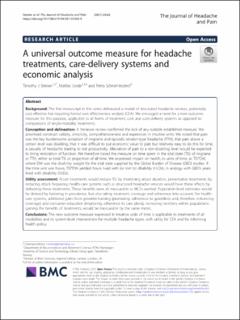| dc.description.abstract | Background The first manuscript in this series delineated a model of structured headache services, potentially cost-effective but requiring formal cost-effectiveness analysis (CEA). We envisaged a need for a new outcome measure for this purpose, applicable to all forms of treatment, care and care-delivery systems as opposed to comparisons of single-modality treatments. Conception and delineation A literature review confirmed the lack of any suitable established measure. We prioritised construct validity, simplicity, comprehensiveness and expression in intuitive units. We noted that pain was the key burdensome symptom of migraine and episodic tension-type headache (TTH), that pain above a certain level was disabling, that it was difficult to put economic value to pain but relatively easy to do this for time, a casualty of headache leading to lost productivity. Alleviation of pain to a non-disabling level would be expected to bring restoration of function. We therefore based the measure on time spent in the ictal state (TIS) of migraine or TTH, either as total TIS or proportion of all time. We expressed impact on health, in units of time, as TIS*DW, where DW was the disability weight for the ictal state supplied by the Global Burden of Disease (GBD) studies. If the time unit was hours, TIS*DW yielded hours lived with (or lost to) disability (HLDs), in analogy with GBD’s years lived with disability (YLDs). Utility assessment Acute treatments would reduce TIS by shortening attack duration, preventative treatments by reducing attack frequency; health-care systems such as structured headache services would have these effects by delivering these treatments. These benefits were all measurable as HLDs-averted. Population-level estimates would be derived by factoring in prevalence, but also taking treatment coverage and adherence into account. For health-care systems, additional gains from provider-training (promoting adherence to guidelines and, therefore, enhancing coverage) and consumer-education (improving adherence to care plans), increasing numbers within populations gaining the benefits of treatments, would be measurable by the same metric. Conclusions The new outcome measure expressed in intuitive units of time is applicable to treatments of all modalities and to system-level interventions for multiple headache types, with utility for CEA and for informing health policy. | en_US |

